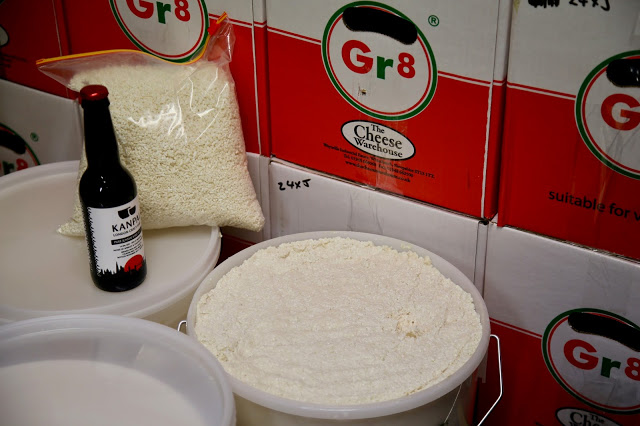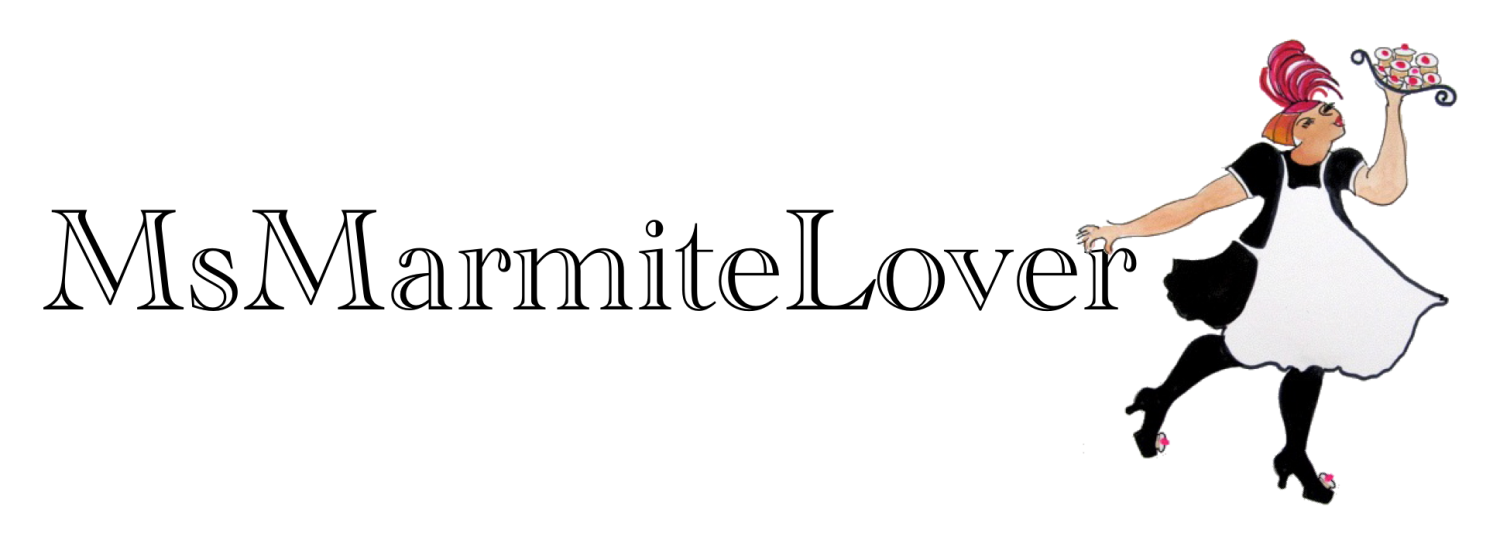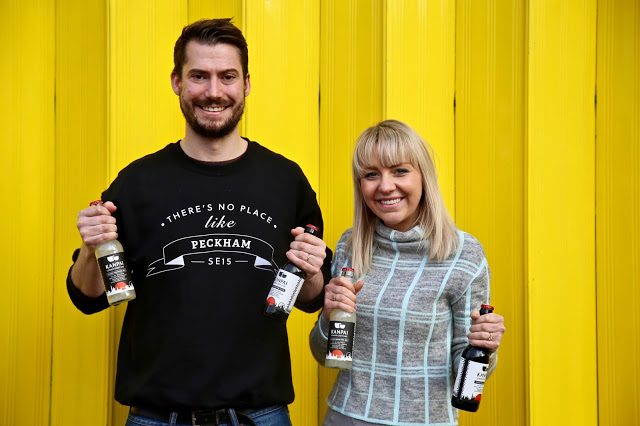Sake, a rice-based alcohol from Japan, is now being brewed in South London by a young English couple, Tom and Lucy Wilson. I visit them at their micro-brewery Kanpai, a tiny room the size of a large cupboard, behind a garage and under a noisy printing press in an industrial estate in Peckham.
Tim hands me a small china cup of sake.
‘This is our latest batch of Junmai, batch 4 since we’ve been in the brewery, just shy of a year now.’ explains Tom. ‘Junmai is our flagship product, a sake that people will be familiar with. It works well with a multitude of foods, particularly spicy food, not just Japanese food.
Lucy adds:
It has some similarities with wine, it’s sitting at 15% strength. Tasting with friends yesterday, we are getting Fino sherry quality, stone-fruit, melony, fruity but savoury.
Good with tapas perhaps?
Lucy: You can drink sake on its own, or put it in cocktails. We personally think it’s perfect with food. It enhances food, in the way that sherry does, it’s umami and savoury.
This is a labour of love. This had a low, slow ferment. The fermentation, including the yeast starter and the fourth ferment, we are looking at 6-8 weeks, we do a traditional drip press with cotton bags. We don’t apply any pressure to it, it’s purely filtered by gravity. The clarity comes through because we do charcoal filtration. We don’t want to strip out any flavours, it’s a very natural product.
Is this the only sake you are making?
Tim hands me another cup from a bottle with slightly yellow liquid and some sediment in the bottom.
From each batch, most of it goes to make Junmai, but we make a smaller amount of nigori. It has a small amount of fine sediment; we add some of the lees back in. It kind of harks back to more of what a traditional sake would be, before fine filtration methods. Even though this is super fine, there are no chunks in.
Some of them are sold with chunks in?
Absolutely. You can get it a bit thicker, a bit chunkier. This is on the lighter side. Our very first nigori, people didn’t like it as much. People were freaked out by it. You get nigori heads, people who are hooked on nigori. This is Marmite – love it or hate it.
It’s more flavourful.
Lucy: You’ve got a bit more of a mouthful, a bit thicker, a bit more tense, on the nose there’s a lot of apple going on. We’ve made this a little bit thinner to make it more friendly for our market here.
Nigori heads? Do you mean in Japan or is that even a thing here?
There is a sake scene in London. There are real aficionados like the British Sake Association, the Japan Society. We love being part of that.
Who are your customers, are Japanese places buying from you?
It is a mixture, Japanese places, plus British, Indian places. Sake is often drunk by people who are into more natural wines.
Mainly we sell to local craft-beer bars, restaurants and cocktail bars. We’ve gone down an alternative channel to begin with. The Japanese food scene is an obvious market.
It’s word of mouth at the moment, so we can keep up with it. We absolutely want to be in Japanese restaurants.
I quite like sake hot, but I know that’s not what you are supposed to do...
Tom: It’s seasonal in my view, I know it’s fashionable to drink chilled sake. But if it’s cold outside, you want something warm to drink! Junmai is more suited to being warmed up.

Tim puts the bottle of Kanpai Junmai sake, which resembles a beer bottle, into a bain-marie.
This is how they do it in Japan, gently, so you don’t burn all the alcohol off. You don’t want it too hot, 45-50ºC maximum.
How did you two get into this?
Lucy: We went to Japan, not particularly focused on sake, just a holiday. We were there for about 3 weeks. We did Tokyo and small places in between; on the way to the small towns we made sure that we popped into sake breweries. The breweries have realised they’ve got to be a lot more open and welcome tourists. So the time we spent there, that started us off.
In Japan, wine and beer are taking over from sake. I think it’s a generational thing, young people think it’s not cool to drink sake, it’s something their grandad did. But it’s coming back. In the last few years there’s been a decline in the consumption of sake, but internationally it’s on the rise.
Who taught you how to make it? Did you just look it up in books?
Tom: Initially self-taught, I was reading any information I could get, all the books available on the market, even getting things from other brewery websites, YouTube, anything.
We did visit some sake brewers in the US as well, got some tips. There’s about a dozen now. We visited one in Texas, some guys from Colorado were in here this week, also California, San Diego, Canada.
Lucy: Then we just starting sharing what we made- we had sake parties, at our flat. People starting liking it. You’d have good and bad batches. We did a fair amount of beer brewing before, so we already had a decent amount of equipment. So, at very little cost, we brewed some small batches…
You’d literally buy ordinary sushi rice and start with that?
Tom: Yeah we also smuggled back Yamadanishiki, a sushi grade rice, from the States. You can’t get sushi grade rice in the UK. Yamadanishiki is the king of rice for making sake. It’s pretty much the most expensive rice you can get your hands on
How much is it?
Tom: About the 7 times the amount of normal rice. You have to buy a pallet normally. It’s only grown for sake production, you don’t eat it. Most of the grains that are grown for sake, are not for eating….
Is that because sake rice isn’t nice?
Tom: It usually lacks flavour. The thing you are after when you are producing sake, is a minimum amount of proteins and lipids and a maximum amount of starch. You want the starch to be collected in a clean disk, the shinpaku (which means ‘white heart’), in the middle, so you mill the outside of the rice down.
When you look at an ordinary grain of rice, the pockets of starch are usually scattered around. For sake, the starch is collected together in one central mass. You minimise the proteins and lipids that go into the tank and you maximise the starch. The starch stays in one piece and gradually gets broken down into sugar by your koji, which is a magic yeast, and then your yeast gets turns that into alcohol, step by step.
It’s a unique way of brewing, a multi-parallel fermentation process.
When you make say wine, you’ve got all your sugar, you press your grapes and you’ve got your sugar juice. With beer, you make your wort by boiling up your malt extract the sugar then add your yeast, so its like a two-step process.
With sake, it all happens at the same time, you don’t start with any sugar. All the ingredients- your koji, rice, yeast, water are all in there working together. The koji and the yeast are in this symbiotic relationship: the koji is breaking down the starch and releasing glucose and turning that into alcohol.

What is koji again? Isn’t that what you use to make miso?
Yes, soy sauce too. Koji is a mould.
I smell and taste the koji, which smells pleasantly of chestnuts.
You make it yourself?
Lucy: You can buy koji covered rice. But making it ourselves is what makes our sake unique. To make it is like having a baby. For 48 hours it’s constant, constant, care. You have to set up an alarm and wake up in the night to tend it.
Have you had much press?
Lucy: For our size, with no budget, yes. There’s not been any marketing. We are sold in Selfridges and the Japan Centre. You have to cut out the middle man when you are a start-up.
We talk about strange food customs in Japan.
Tom: I ate live lobster. I didn’t really have a choice it was a business meeting in Hong Kong.
Did you think if I don’t eat this live lobster I wont get the deal?
Tom: I was being treated and it was customary to accept.
Lucy: We love that not really knowing what you are eating element about Japan. We had a rectum on a skewer.
Whose rectum? What animal?
Not sure. It was yakitori…
Did it look, er, rectumy?
It was just written on the menu. It was singular, quite big.
Big enough to stick on a skewer?
Laughs.
Do you do this full-time?
Tom: We still do our current jobs, we work during the day. We are in London and we’ve got overheads. We require salaries. I work in financial marketing, in a bank, my day job is sitting at a desk in front of a computer.
Do you hate it?
No, but in an ideal world this would be our sustainable passion.
Lucy joins in: I work in communications, it’s hard, we are burning the candle at both ends.
Are you knackered?
Yes we are limited by time. We need to hire in some help. We are in this limbo period where we’d love to expand and give more money and time to it
Are you getting more orders than you can fill?
Yes. We have organic growth at the moment. Last year was setting up, getting licensed. HMRC don’t have a sake category. They sort of ummed and ahhed, we ended up in ‘made wine’. Any alcohol that is fermented, gets put into ‘made wine’.
The process doesn’t cost anything, the actual licence?
No you just have to apply and appear, get it sorted. You have to stay on top of your operation.
Do you have hygiene inspections?
Tom: Yes, that’s organised by our local council, annually. Southwark is so busy, with so many businesses. It’s not tricky to comply with, a lot of its common sense. We have a cleaning register. Because we aren’t hiring staff, we know whats going on. To produce this product -everything has to be so sterile. Our own standards are very high. Everything is done here. We designed our own logos. We do all our own bottling- 200 bottles at a time.
What’s your turnover at the moment?
Tom: We produce 1000 x 330ml bottles every 3 months and we are doing a batch every couple of months.
Japanese brewers come here to taste?
Lucy: People have come to visit us in this space. The Japanese know of us now and when they come over for other events, say at the Japanese embassy, they visit us. Even before we had the brewery, we met people at tasting events.
Lots come here and now we are going to visit them in return. That’s been one of the best things about this journey. We’ve met so many people. And the Peckham scene is cool and very supportive.

What about water? The Japanese are obsessed with water…
We use Peckham Spring. (Laughs) Most water used in Japan is very soft.
The biggest difference is that with all the minerals that are in hard water, yeast loves minerals, so it gives it more vigour, We have to be really careful about lowering the temperature, we counter-act the extra vigorous ferment by lowering the temperature. We still want that low and slow ferment.
What about getting a water softener?
Lucy: We want to avoid adding anything to the water, to our sake. We have carbon filtration of the water coming in, so it removes any heavy metals, but we don’t adjust the pH. We want to keep it as natural as possible. Also you’d have to replicate it every time, which is making a rod for your own back.
Southwark has the most amount of breweries out of any borough in London and they all say, don’t touch the water, make the most of what you have. We aren’t trying to replicate Japanese sake.
You are making a very London sake?
Lucy: Yes. There are over 1000 Japanese sake brewers, why would we want to imitate them?
Do they notice the difference?
Yes they find it very dry. They like it. They recognise that it’s sake but also that it’s totally different. We aren’t competition. They take it as a massive compliment.
Tom: I did brew school in Japan last year, I took a load of bottles there. Feedback was phenomenal. I had 2 or 3 types analysed there. They put it through their laboratories which was invaluable. We don’t have that kind of specialist knowledge here.
Any changes they recommended?
One of the takeaways was on our koji production. We are over the moon because for our latest batches, we’ve changed our koji production ever so slightly and our product is significantly less acidic.
The most common thing you find when talking to international sake brewers, is they have really high acidity. That’s the stand-out difference between Japan and others.
You visited Japan in 2014. Within three years you are making your own sake. That’s amazing.
Lucy: It overtook our flat. To the point that my mum cut her head on a piece of equipment. That’s when we realised we had to get a premises.
We’d love to be in a railway arch situation but they are extortionate. Arches in Peckham are 30k a year in rent. If you want to be in the Bermondsey beer mile, double that. And that’s without business rates.Our goal in 2018 is to expand, to grow, our ultimate goal is basically be somewhere where we have a frontage, a tap room, where people can taste. Accessibility is key: smaller bottles, serving sake by the glass to people, serving it on tap. Then you can mix it up and do flavours, and we are releasing a sparkling sake.
Ooh lovely.
A full batch is going to be sparkling, in these half champagne bottles. In bottle carbonation with really fine champagne type bubbles. We are keeping things natural, not overcomplicating stuff.
Even though our equipment is stainless steel and modern, all the techniques are completely traditional and hand-made.
How much money have you spent on equipment so far?
Tom: Double figures -20k?
Would you get other people investing?
To jump to the next level, we need investment.
Would you do Dragons Den?
Tom: I find the show stressful, it’s stressful to watch.
Lucy: If we are going to go down the investment route, we’d be looking for a partnership, somebody in the food and drink industry.
At the end of the visit, Tom and Lucy give me some sake lees to make pickles.
Kasu Pickles Recipe

I’ve seen that people make a kind of pickle bed, using a flat shallow plastic container, with layers of different vegetables for pickling. Here I’m using cucumbers, on an enamel tray, but you can also try white fish filets, beetroots, radishes, ginger.
You’ll need some ‘kasu’, fermented sake rice lees or leftovers. It smells very alcoholic.
Ingredients:
(Quantity depends on how much you want to make)
12 small cucumbers, cut lengthways in quarters
6tbsp Sea Salt
3tbsp caster sugar
250g or more Kasu
Optional: grated ginger, grated garlic, lemon zest, sweet mirin.
Method:
First salt the cucumbers or other vegetables. Simple sprinkle with 3 tbsp of sea salt/sel gris or kosher salt.
Leave overnight weighted down.
Mix the kasu with the rest of the salt, the sugar and make a ‘bed’ in a flat non-reactive container.
Lay down the cucumbers.
Cover with another thin layer of the kasu mixture.
Leave weighted down for a few days.
Rinse off and eat with rice for instance.






Leave a Reply